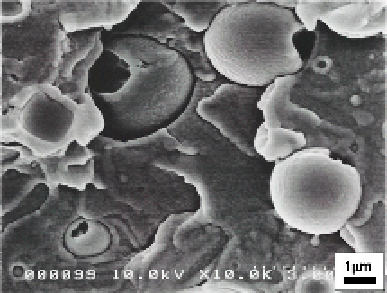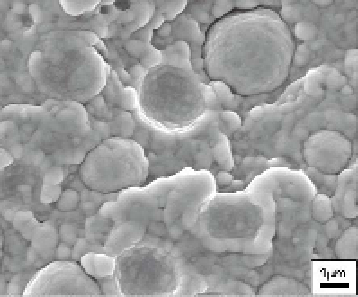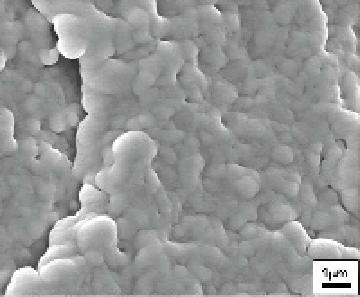Biomedical Engineering Reference
In-Depth Information
effectively improved. However, blending of ductile PCL with PLA degrades another
mechanical properties such as strength and elastic modulus of the base polymer PLA.
Recently, Tsuji et al. found that the mechanical properties such as elastic modulus and
tensile strength of PLA could be improved by annealing (Tsuji et al., 1995). It is thus
expected that annealing process may also affect on the mechanical properties of
PLA/PCL/LTI blend.
FE-SEM micrographs of cryo-fracture surfaces of quenched and annealed PLA/PCL and
PLA/PCL/LTI are shown in Fig.19. Both the quenched and the annealed PLA/PCL show
spherical structures of PCL. It is obviously seen that PCL spherulites in PLA/PCL/LTI are
much smaller than those in PLA/PCL. The annealed blends exhibit rougher surfaces with
spherical structures than the quenched samples. These spherical structures are thought to be
the spherulites of PLA generated by crystallization during annealing process.
(a) Quenched PLA/PCL (b) Annealed PLA/PCL
(c) Quenched PLA/PCL/LTI (d) Annealed PLA/PCL/LTI
Fig. 19. FE-SEM micrographs of microstructures of PLA/PCL and PLA/PCL/LTI.
Effects of annealing on the elastic modulus,
E
, and the strength,
σ
f
, under three-point
bending condition are shown in Fig.20. Both
E
and
σ
f
increase due to annealing. Effects of
annealing on the crystallinity,
x
c,PLA
, and the molecular weight,
M
w
, are also shown in Table
1. It is clearly seen that
x
c,PLA
dramatically increases due to annealing. Thus, increasing
x
c,PLA
is likely to strengthen the structure of the polymer, resulting in the increase of
E
and
σ
f
.
M
w
of PLA/PCL increases slightly due to LTI, suggesting that LTI is thought to generate





